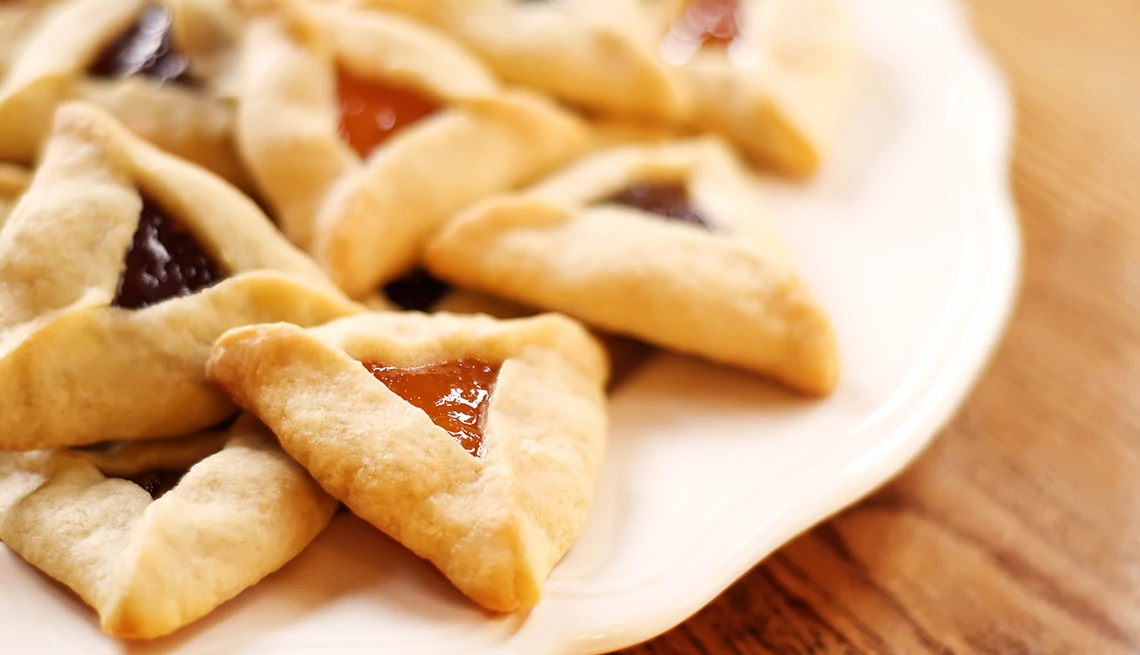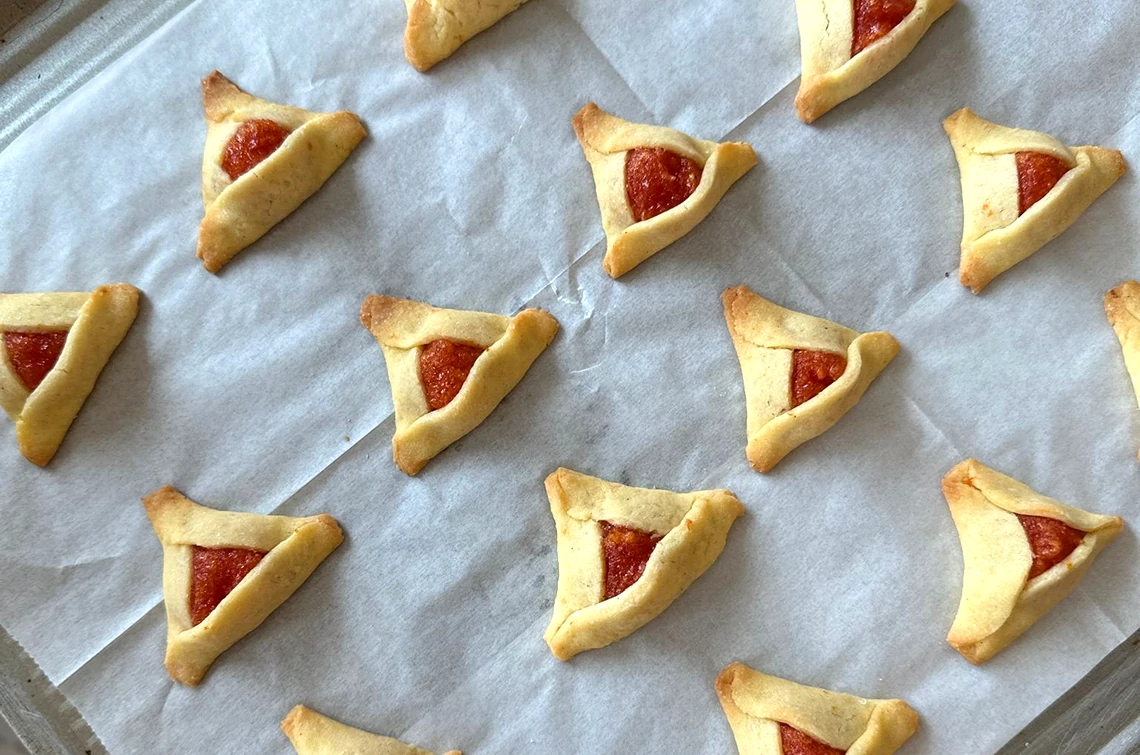Staying Fit


In late March, Lisa Fields, 50, of Cherry Hill, New Jersey, will be elbow-deep in dough. It’s time for hamantaschen, delicious triangle-shaped cookies with any number of tasty fillings, traditionally made for the Jewish holiday of Purim.
Fields says she and her children have made hamantaschen every year since the kids were toddlers — even if they didn’t hit the holiday exactly. “One year, I don’t think we baked the cookies until July because there were so many things on the calendar that year, but my kids insisted.” Such is the strength of tradition — and the promise of cookies.


AARP Membership— $12 for your first year when you sign up for Automatic Renewal
Get instant access to members-only products and hundreds of discounts, a free second membership, and a subscription to AARP the Magazine.
Purim, celebrated this year from sundown March 23 through sundown March 24, centers around the story of Esther — a Jewish queen who, along with her cousin Mordecai, saved the Jewish people from Haman, the Persian king’s adviser who ordered all Jews in the kingdom killed.
To commemorate the holiday, here are three recipes — hamantaschen, kadoo bishak and pomegranate sumac margaritas — as well as a few other ways to get into the spirit.


Cookies to eat and share
Hamantaschen Tips
- Hamantaschen dough “is not the simplest to work with,” Sussman says. “If you’re in a hurry, use store-bought pie crust. It’s flaky and delicious.”
- Avoid over-flouring the dough, or it will dry out. A tackier dough will stick together better.
- Don’t overstuff your hamantaschen. Most fillings expand. Store-bought jam is fine, but use one that’s dense and of good quality to avoid leakage. If you want something chocolaty, Nutella is a great filling.
- The cookies will hold their shape better and have less leakage if, instead of pinching the ends, you fold them one over the other and press to seal.
- Form your cookies on a baking tray and put them in a freezer for a few minutes before baking.
The hamantasch is Purim’s most recognizable treat. They’re usually filled with jam or mohn (German for poppy seed; taschen means pockets).
“Mohntaschen [a yeasted-pastry filled cookie] were a German-Austrian treat being served around the 16th century,” says Shannon Sarna, author of Modern Jewish Comfort Food and founding editor of The Nosher website. “European Jews thought ‘mohn’ sounded like Haman.”
Though tricornered hats weren’t common in Haman’s era, it’s likely that when they became fashionable, they were associated with the cookie, according to cookbook author Giora Shimoni on The Spruce Eats website. Thus, a tradition was born.
If you don’t like jam or poppy seed, fear not. “You find flavors in anything you can imagine: tahini, praline, matcha,” Sarna says. She’s even seen dough with tiny chocolate chips or funfetti. Her kids’ favorite filling is s’mores.
She’s seen hamantaschen fancied up by dipping one corner in chocolate and adding sprinkles or nuts or drizzling lemon curd on top.
Sharing your hamantaschen is as much a part of Purim as the treat itself. During the holiday, adults who celebrate are required to give food to at least one friend. The tradition is called mishloach manot (meesh-low-ach mah-note). Adeena Sussman, chef and author of Sababa: Fresh, Sunny Flavors From My Israeli Kitchen and the more recent Shabbat: Recipes and Rituals From My Table to Yours, fills baskets with homemade seasonal jams, hamantaschen, dried fruits, nuts and homemade liquor. Sarna makes boxes and fills them with sweets to give to her children’s teachers.
MINI MARMALADE HAMANTASCHEN
(Makes 50-60 mini hamantaschen or 25-35 regular-sized ones)
INGREDIENTS
- 1½ sticks unsalted butter, softened and cubed
- 2/3 cup sugar
- 1 egg
- 1 teaspoon vanilla extract
- 2 cups plus 2 tablespoons flour, sifted, plus more as needed
- ½ teaspoon fine sea salt
- 1 cup orange marmalade or filling of your choice
DIRECTIONS
1. In the bowl of a stand mixer fitted with a paddle attachment, beat butter and sugar over high speed until fluffy, three minutes. Add egg and vanilla, beat until just combined, reduce the speed to low, add flour and salt, and beat until a sticky dough forms, two minutes.
2. Transfer to a floured work surface. Knead, adding up to 2 tablespoons flour if needed, until smooth but not dry (add water if needed), two minutes. Divide into two 5-inch discs, wrap each in plastic, and chill at least two hours or up to 48.
3. Preheat oven to 350°F. Arrange one of the discs on a lightly floured work surface and roll out to no more than 1/4-inch thickness (1/8 inch is better!), dusting dough with flour, flipping to prevent sticking.
4. Use a 2-inch cookie cutter to cut as many rounds as possible from the dough (collect scraps, roll and cut again). Arrange a scant teaspoon of filling into each hamantasch. (Resist the urge to overfill!) Repeat with remaining dough discs.
5. Pick up a hamantasch and fold in the left side, fold in the right side, then pull up the bottom, folding each side under another to secure the filling. Press the edges to seal, transfer to parchment-lined baking sheets, and bake until golden, 16 to 17 minutes.
6. Cool completely. Store in an airtight container for up to five days (or freeze for up to three months).
7. You can make the hamantaschen 3 inches in diameter and use 2 teaspoons filling per hamantasch.






































































More From AARP
8 Easter Activities Great for Ages 9 to 99
A little planning can keep everyone entertained — and feel included — during the holiday9 Easter Crafts to Do With the Grandkids
Sweet treats, colorful dyed eggs and easy art projects are a great way to connect
5 Essential Elements of Easter Brunch
Delicious dishes that make the holiday meal a treat
Recommended for You